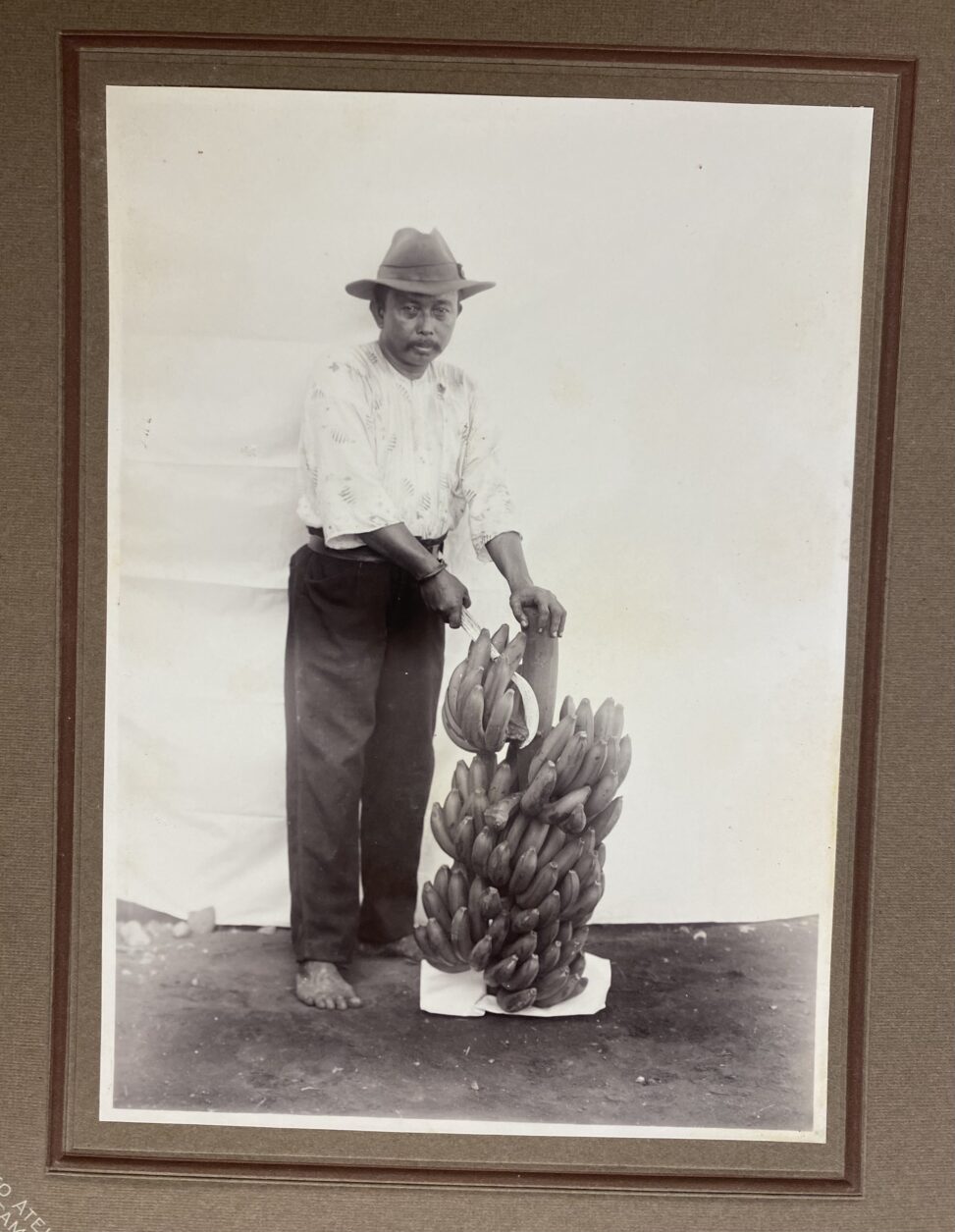Title: Pisang Ambon
Year: 1925
Location: East Java
Photographer: Atelier “De Famora”
A photo album taken in 1925 documenting the banana trades of East Java, including many photographs of men selling bananas on the street to the farms where they are harvested, but one photograph in particular depicts a man standing next to a pile of bananas with no title but only the caption, P. ambon poetik of t. wel(?) P. ambon biasa. Koesno V.P. 14/7/1925 which is, “referring to Pisang ambon, the type of banana commonly available in Indonesia”.Through information from outside sources we can infer that the meaning and purpose of the photograph is to promote the banana industry in East Java, the meaning is consistent with all differing parties and their perspectives of the photograph.
Within the borders of Indonesia lies East Java, a country filled with a rich history of dynasties large enough to create trade routes that would expand as far as the eye could see. “When the power of Central Java waned in the 10th century the vacuum was filled by East Javanese kings who established the Majapahit Kingdom that at its height in the 13th century included all of present-day Indonesia as well as the Malay peninsula and the Philippines. Under the Dutch, East Java was turned into a major plantation area, with coffee, cacao and rubber being the major cash crops” through the actions of the Dutch, East Java was set down a path of agriculture and we will see this until the present day. Along with the photograph came a small description saying, “The vivid images, several revealing an eye for artistic composition, record the harvest and transport of bananas in the busy coastal port of Banjoewangi (now Banyuwangi) in the then Dutch East Indies.” which also suggests that the purpose and the meaning of these photographs was to get other investors from foreign countries to invest in east java to better their economy.
The second source being The Mark of Empire – S1E4: Majapahit (weekly memo 3) in which the film goes through the history of Majapahit, a 700 year old empire that dominated Indonesia and “built a trading empire so vast, that it stretched across much of the spice root”. The monsoon trade winds would blow from east between June and September bringing merchants from the spice islands carrying clove, nutmeg, and maize in which they would trade for rice. Months later the monsoon winds would change to the west bringing in new merchants carrying with them porcelain, beads, and textile goods and trading them for spices. Through interactions between merchants and the people of The Majapahit Empire new cultures and new opportunities arose. Similarly the photograph taken by Atelier “De Famora” meant new opportunities for the local people of East Java. The meaning of the photograph for the local people would mean new opportunities, attracting new eyes and promoting the banana industry at the time to foreigners. More interactions would then lead to an improved economy for the people of East Java.
The third source is U.S. or China: Will Southeast Asia Have to Choose a Side? (weekly memo 4) in which the film looks through the perspectives’ of Vietnam and the Philippines and how The United States and China have affected both countries and whether or not they have to choose between the two. For the Philippines, “since coming into office in 2016 president Duterte has made infrastructure development a priority, to help realize his grand vision he has secured billions of dollars in pledged infrastructure funding from China”. This would include a “500 hectare development investment with China and it will be beneficial as long as it creates job opportunities and respects Philippine culture”.For Vietnam one visit from the acting, “U.S. President Bill Clintin visit officially signified the normalizing of relations between the U.S. and Vietnam, 25 years after the Vietnam War ”. Through this one visit Vietnam was now seen by the world to be open for international trade and now does business with nearly every country in the world. Both superpower nations have left their marks on these southeast asian countries, improving their economy and infrastructure through diplomacy as well as foreign investment, Similarly the purpose of the photograph could be seen to introduce new opportunities into the economy of East Java. The meaning of the photo for the photographer could be to help and promote the banana industry, perhaps to potentially attract foreign investors into East Java and boost its economy. Furthermore, the purpose of the photo could just be due to the curiosity of the photographer, to document their adventures and learnings of East Java and the banana industry there.
Citations:
Hays, Jeffrey. “East Java.” Facts and Details, 2019, https://factsanddetails.com/indonesia/Places/sub6_10b/entry-6777.html.
“The Mark of Empire – Majapahit.” CNA, 24 May 2020, https://www.channelnewsasia.com/watch/mark-empire/majapahit-1472441.
“US or China: Will Southeast Asia Have to Pick a Side? | When Titans Clash | Ep 4/4 | CNA Documentary.” YouTube, YouTube, 29 Jan. 2021, https://www.youtube.com/watch?v=lJ8A5jiGICM.
